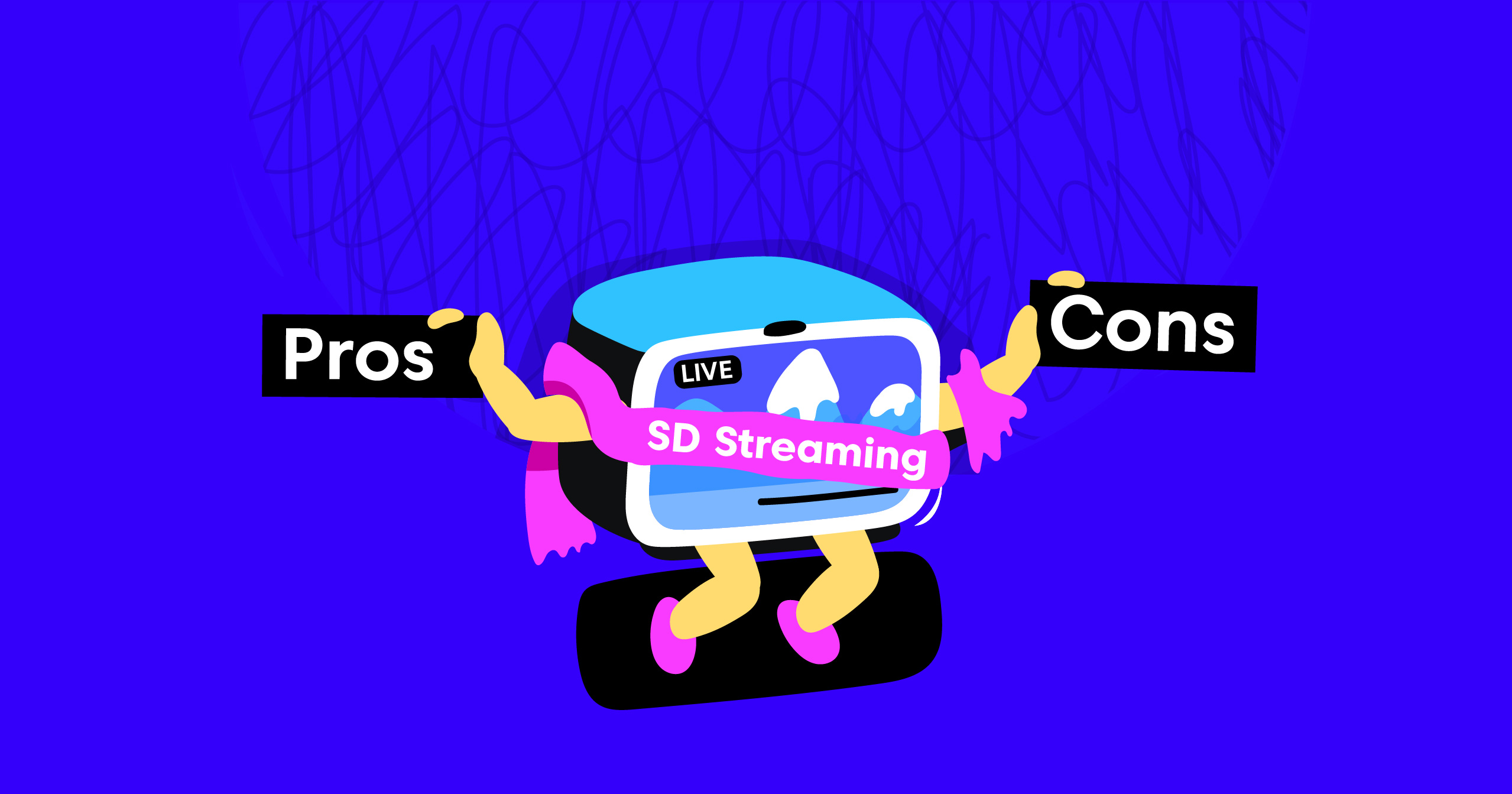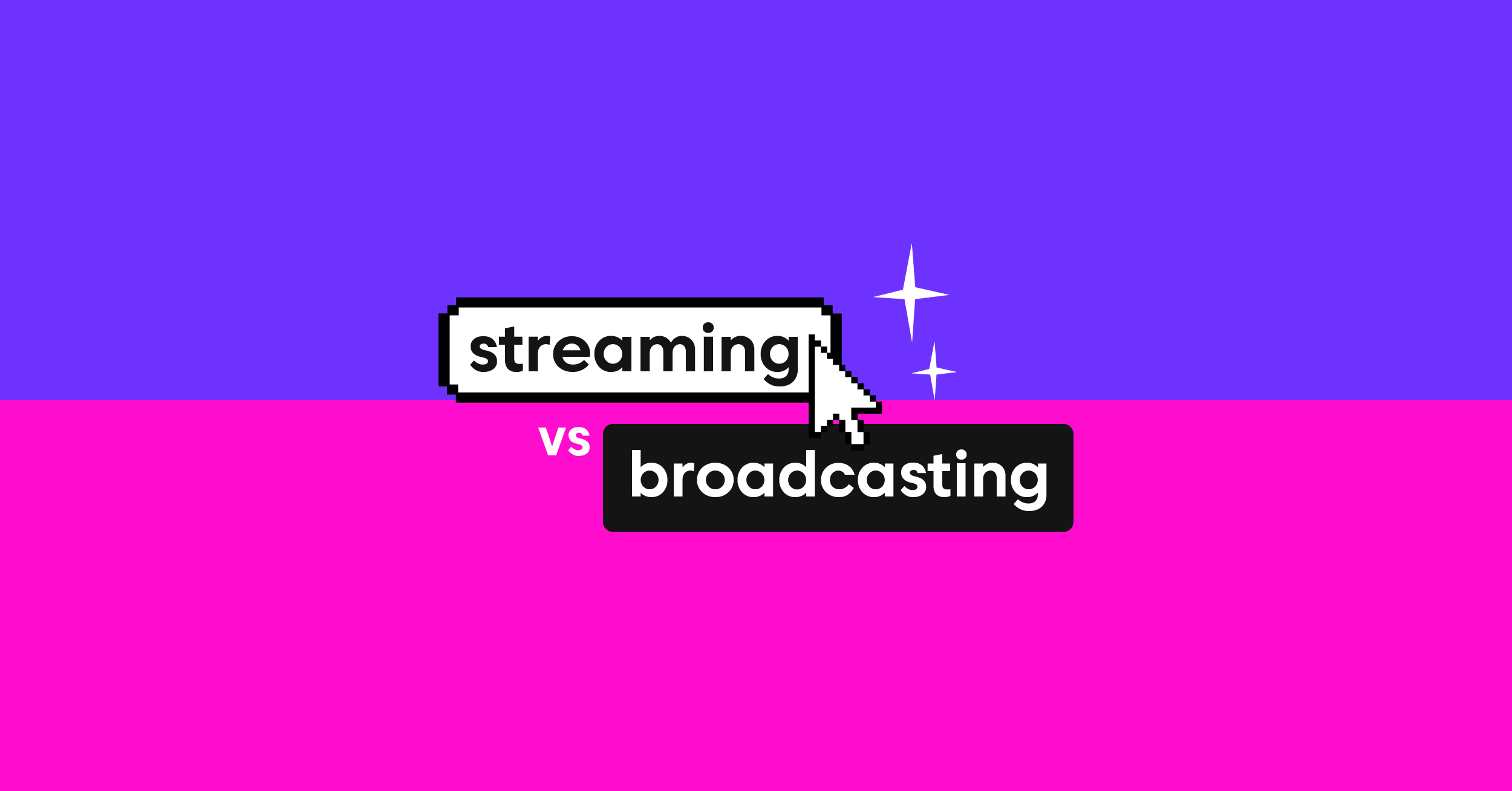SD Live Streaming, which stands for Standard Definition Live Streaming, has both advantages and disadvantages. On the positive side, SD streaming is compatible with various devices, making it accessible to a wide audience. It requires less bandwidth, resulting in faster loading times and less buffering. SD streaming is also suitable for multistreaming on multiple platforms simultaneously.
However, the downside is that SD videos have lower quality and resolution compared to HD streaming. They lack sharpness and detail, which may not meet the expectations of viewers who are used to higher-quality visuals. Additionally, SD streaming may result in blurry images or artifacts, particularly in fast-paced scenes.
What is SD Streaming?
SD streaming, or Standard Definition streaming, refers to the delivery of video content with a lower resolution and video quality compared to HD streaming. In SD streaming, the video resolution is typically 480p, which provides a decent viewing experience on smaller screens like mobile devices or computer monitors.
While SD streaming doesn’t offer the same level of video clarity as HD streaming, it still allows users to enjoy online video content without requiring a high upload speed or more processing power. With SD streaming, viewers can watch live streams or pre-recorded videos with acceptable quality, although they may lack the sharpness and detail provided by HD resolutions.
The main advantage of SD streaming is its compatibility with various devices and its ability to consume less bandwidth. SD videos have a lower pixel count, resulting in smaller file sizes and quicker buffering compared to higher-quality video streams. This makes SD streaming a suitable option for viewers with limited internet connections or those who prefer to stream on multiple platforms simultaneously.
It’s important to note that SD stands in contrast to HD (High Definition), which offers a higher video quality and resolution. HD streaming, with its higher bitrate and better video quality, provides a more immersive and visually appealing experience, especially on larger screens. The resolution refers to the number of pixels displayed on the screen, and HD resolutions such as 720p or 1080p offer more pixels than SD resolutions.
In summary, SD streaming serves as a practical solution for those seeking to start streaming or those with limited internet connectivity. While it may not deliver the best quality, SD streaming offers a viable option to enjoy online video content without requiring high-resolution displays or substantial bandwidth. However, for viewers desiring higher quality videos, HD streaming with its superior video resolution and clarity remains the best choice.
SD vs. HD Streaming: Which is Better for Live Streaming and Video Quality?

When it comes to live streaming and video quality, the debate between SD (Standard Definition) and HD (High Definition) streaming is an important one. The video resolution and quality can greatly impact the viewing experience, whether it’s for online video content or live video streams. So, let’s explore the differences between SD and HD streaming and determine which one stands out as the better option.
SD streaming refers to videos that have a standard definition resolution, typically at 480p. Although it is considered a lower-quality option compared to HD streaming, it can still provide a satisfactory viewing experience, especially on smaller screens like mobile devices or older computer monitors. However, the limited pixel count and lower stream quality can result in blurry images and less detail compared to HD videos.
On the other hand, HD streaming offers a higher video quality with more pixels and a sharper image. With HD resolutions like 720p or even Full HD (1080p), viewers can enjoy a high-quality video experience on larger screens or high-resolution devices. HD videos have a widescreen aspect ratio and a higher bitrate, ensuring better video quality overall.
HD stands out as the winner when it comes to video streaming, particularly for live streams and online video content. The higher resolution, combined with the wider aspect ratio and better video quality, provides a more immersive viewing experience. HD videos are also more compatible with modern devices and platforms, allowing users to stream in HD across multiple platforms simultaneously.
It’s worth noting that streaming in HD requires more bandwidth and processing power compared to SD streaming. Higher-quality videos demand a higher upload speed and more processing power, both for the content creator and the viewer. Additionally, some older devices or slower internet connections may struggle with buffering compared to SD streams.
In summary, while SD streaming can suffice for very basic parameters, HD streaming is the clear winner for those seeking higher quality, more detailed video content. With its superior video resolutions, wider aspect ratio, and overall better-quality video, HD stands out as the best choice for live streaming and online video content. Whether it’s for television broadcasts, online platforms like YouTube or Facebook Live, or simply enjoying high-quality video on your computer or mobile device, HD streaming provides the best quality and viewing experience. So, start streaming in HD and elevate your video content to new heights.
Is SD Streaming Good?
The answer depends on your preferences and needs. SD streaming refers to standard definition video streaming, which has a lower video resolution and quality compared to HD streaming. While SD streaming may not offer the same level of visual clarity as HD video streaming, it can still be a viable option for certain situations. If you’re watching videos on smaller screens like mobile devices or older computer monitors, SD streaming can suffice. However, if you crave higher video quality and enjoy watching content on larger screens, HD streaming with its high-definition resolution and better video quality would be the way to go.
The difference between SD and HD video resolutions is striking. SD videos have a lower pixel count and lower resolution, resulting in less detail and clarity. On the other hand, HD videos boast a higher pixel count and resolution, enabling a crisper and more immersive viewing experience. Whether you’re watching live streams or pre-recorded videos, the disparity in quality between SD and HD is noticeable. With HD resolution, every frame is packed with more pixels, delivering a high-quality video that captures finer details and enhances the overall visual appeal.
When it comes to live streaming, higher video quality is crucial. If you’re broadcasting live events or sharing your content with an audience, HD streaming can make a significant difference. Viewers appreciate the improved clarity and sharpness of HD videos, which can enhance their engagement and overall viewing experience. Whether it’s a live video stream or a pre-recorded session, opting for HD resolutions ensures that your content stands out with its superior quality.
SD vs. HD debates often revolve around the differences in video quality. While SD videos serve their purpose in some cases, HD videos offer a far better experience. With their high-definition resolution, HD videos display content in more vivid and lifelike ways. The distinction is particularly evident in the details, colors, and overall sharpness. HD resolution, also known as Full HD, provides a widescreen aspect ratio that better matches today’s devices and screens, offering an immersive viewing experience for users.
Online video consumption has grown significantly, and streaming platforms now offer a multitude of content choices. When streaming on multiple platforms simultaneously, HD streaming ensures that your content is of the highest quality across various channels. However, it’s important to consider factors like upload speed and bandwidth, as streaming in HD requires more processing power and a stable internet connection. If you have limited resources or face bandwidth constraints, SD streaming might be a more viable option.
SD and HD are terms commonly used in video streaming. SD stands for Standard Definition, while HD stands for High Definition. SD quality, often associated with older television broadcasts, relies on interlaced scanning and has lower resolution. In contrast, HD quality delivers higher resolution, progressive scan, and a better overall viewing experience. The disparity in quality is noticeable, especially on larger screens or when comparing both SD and HD content side by side. HD videos offer better clarity, reduced blurriness, and an overall better viewing experience.
(HD vs SD) The choice between SD and HD streaming depends on your specific requirements. SD streaming can be suitable for smaller screens and situations where video quality is not a top priority. However, if you seek better video quality and a more immersive experience, HD streaming is the way to go. HD resolution, with its higher pixel count and superior video quality, ensures a visually appealing and engaging viewing experience. Whether you’re streaming live events or sharing pre-recorded videos, HD streaming offers the best quality and delivers content that stands out. Consider your device, internet connection, and preferences to determine the optimal streaming option for you.
SD Streaming Data Usage
Streaming data is a type of data transfer that occurs in real-time, meaning it is transferred and received almost instantly on multiple platforms simultaneously. SD streaming data usage refers to the amount used when streaming Standard Definition (SD) content online.
When you stream SD content, your device downloads a constant flow of data from the internet to display high-quality video. This data usage can vary depending on the video’s length, the stream’s quality, and the device used for streaming.
Streaming SD content typically uses less data compared to streaming High Definition (HD) content. However, the exact amount of data used will depend on various factors, such as the bitrate of the stream and the streaming platform.
Keeping track of your SD streaming data usage is important to avoid exceeding your monthly data cap and incurring additional charges from your internet service provider. You can monitor your data usage by checking your internet bill or using data monitoring tools provided by your ISP or streaming platform.
Exploring SD Live Streaming: Pros & Cons of SD Streaming
Users can watch or listen to the best quality media without downloading the entire file by streaming, which transfers data over the internet. SD streaming is the term for online video in standard definition.
The followings are some benefits and drawbacks of SD streaming:
Pros:
- Less bandwidth requirements: SD streaming uses less bandwidth than HD or 4K streaming. Those with slower internet connections can still enjoy their preferred video content without any buffering problems.
- Cost-effective: Most SD streaming services are cheaper than HD or 4K. Because of this, it is a viable choice for individuals on a limited budget.
- Faster streaming: SD streaming uses less bandwidth and does so with a reliable internet connection.
- Device compatibility: SD streaming is compatible with various devices, including outdated smartphones, tablets, and computers. This implies that people can access their preferred video content on different devices.
Cons:
- Lower quality: Compared to HD or 4K streaming, SD streaming provides lower-quality video and audio. This may be obvious on larger display screens or high-quality audio systems.
- Restricted content availability: Some streaming providers might only offer some content in SD resolution. Some of the shows and videos that users enjoy can be missed.
- Less immersive experience: SD streaming might not deliver the immersive experience that comes with higher-quality video and audio. This can be especially significant for entertainment, like action movies or music performances.
- Compatibility problems: While trying to watch the video, some devices may not support SD streaming or be unable to show it effectively.
SD Live Streaming with Castr
A powerful tool that enables users to stream live video footage online is SD Live Streaming with Castr. You may broadcast your event in high definition to viewers worldwide using Castr.
SD Live Streaming with Castr is simple and easy to use. You may start streaming your event live in a matter of clicks with just a camera and an internet connection. Castr’s user-friendly interface makes setting up and modifying your broadcast to suit your needs simple.
The incredible versatility of SD Live Streaming with Castr is one of its many wonderful features. No matter what kind of event you’re streaming—a conference, a concert, or a sporting event—Castr provides the capabilities you’ll need to succeed. To give your viewers the best experience possible, you can enhance your stream with overlays, lower thirds, and other graphics and switch between different cameras and viewpoints.
The reliability of SD live streaming with Castr is another benefit. Castr uses a vast network of servers to guarantee that viewers receive your stream with the least lag and buffering. This implies that viewers can watch your stream uninterruptedly from anywhere worldwide.
All things considered, SD Live Streaming with Castr is a fantastic solution for anyone wishing to stream live video online. Anyone looking to share their event with a worldwide audience will find it the ideal choice due to its simplicity of use, adaptability, and dependability.
Final Thoughts (Pros & Cons of the SD and HD Video Streaming)
Standard definition streaming, or SD streaming, has its benefits and drawbacks. On the one hand, SD streaming uses less data. It is simpler to stream on slower connections, making it more accessible to those with constrained bandwidth or those who live in remote locations without reliable internet access. Also, it uses less powerful devices, making it simpler to watch on older ones.
Unfortunately, the video’s lower quality and potential for grainy or distorted images detract from the viewing experience. Also, many modern TVs are designed for HD or better quality, making SD streaming seem archaic.
Your priorities and the trade-offs you’re ready to make in exchange for a more convenient and economical viewing experience will ultimately determine whether SD streaming is the right choice for you!









